Getting Around: Alternative Transportation in Copenhagen
As I’ve gotten more settled in over the past few weeks, I’ve learned a lot about various alternative transportation systems in Copenhagen. The city is divided into zones, with zones 1, 2, and 3 encompassing the main parts of Copenhagen and higher numbers representing regions further from the center. The zones are the basis for most of the public transportation (i.e. ticket pricing) within Copenhagen.
Biking
As I mentioned last time, biking in Copenhagen is huge and many people choose to bike as their primary mode of transportation throughout the city. Some quick history about biking in the city. Biking was first introduced in Copenhagen in the 1880s and became a widespread phenomenon by the 1930s, as it was a symbol of equality, one of the hallmarks of Danish society. But, cars soon began to replace bicycles around the 50s, and Danes fell into the common mindset that cities needed to be built for the automobile. The oil crisis in the early 1970s really impacted drivers in the city, however, and biking made a comeback in Copenhagen, leading to the widespread installation of biking infrastructure.
This well-designed biking infrastructure is what makes biking an extremely efficient way to navigate around Copenhagen, something I’ve noticed from my first day of being here. All of the big, busy streets throughout Copenhagen have designated bike lanes that are elevated slightly from the road to separate bikers from both cars and pedestrians. This feature of bike lanes is really conducive to encouraging biking because it helps bikers (me included) feel safer from automobile traffic. The bike lanes are placed between parked cars and pedestrian sidewalks, at least for those roads that actually permit parking, which again helps prevent bikers from feeling like they could be hit easily. The bike lanes are wide enough to accommodate two bikers, allowing people to pass each other and go at their own comfortable pace.

Here is an example of the typical road layout in Copenhagen. The bike lanes are sandwiched between pedestrian sidewalks and parked cars.
Smaller roads also have bike lanes, but they may just be painted onto the road instead of being elevated. Because there is less traffic on small roads, this aspect doesn’t inhibit bikers. And, because biking is so widespread, there are much more explicit right-of-way rules that dictate relationships between bikers and drivers. There is also a general awareness of bikers being important participants in road traffic, and drivers are definitely aware of bikes which of course comes with the widespread biking culture.
There are many, many bike shops in Copenhagen. I see one every few blocks in the city center, as well as repair shops, and places like WeCycle Cafe that are centered around biking culture. Bike share programs have started popping up, too, which allow people to pay as they bike for a short period of time. Donkey Republic, a bike-sharing company that originated in Copenhagen, has its notable orange bikes all over the city, and Bycyklen is a relatively new initiative of the Copenhagen government to provide electric bikes with GPS to people through an app-based sharing program.
The Metro
The metro system in Copenhagen is relatively new; the first stations opened under twenty years ago, in 2002 and the system has been expanding ever since. Right now, it consists of three different lines, M1, M2, and M3. The next line, M4, is under construction and is set to open on March 28, 2020! And, as housing in the city expands, new stations are being built to ensure that everyone living within the limits of Copenhagen is at most a ten minute walk from a metro stop. Overall, the metro currently services 9 miles of route, which is technically considered a bikeable distance.
The metro has been designed to have small trains of only two or three cars that depart from stations frequently, which has made it really easy for me to plan trips when relying on the subway. In my experience, the trains are always on time and efficient, as the doors only stay open for about 15 seconds at each stop. Navigating by using the metro is also extremely easy, with clear maps in the stations and in the trains themselves, as well as on various public transportation apps.
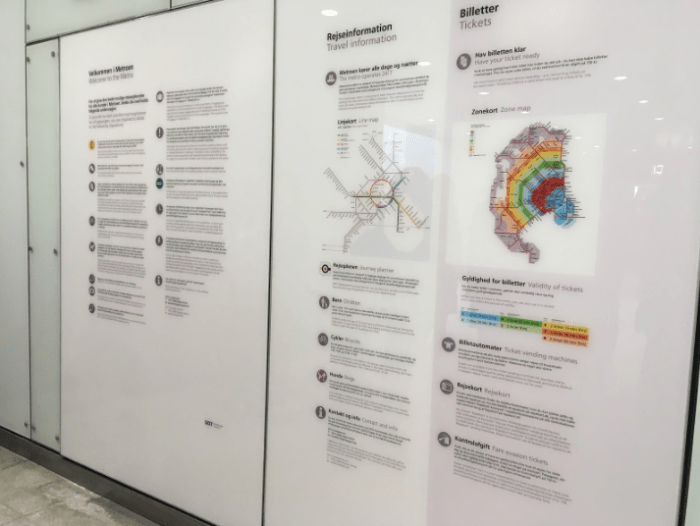
An informational sign found in many of the metro stations that clearly explains the ticket system and has a useful map.
The stations and trains are very clean, quiet, and pleasant to be in. Each station has the same general design, with unique features that are supposed to encompass the vibe of the specific neighborhood. For example, one of the stations uses marble while another uses brick, even those the overall layout is identical. One other really cool feature of the Copenhagen metro system is that all the trains are automated and driverless. It’s fun to sit in the front of the train because there is a huge window where the driver would usually be, providing cool views of the underground and the outskirts of the city.
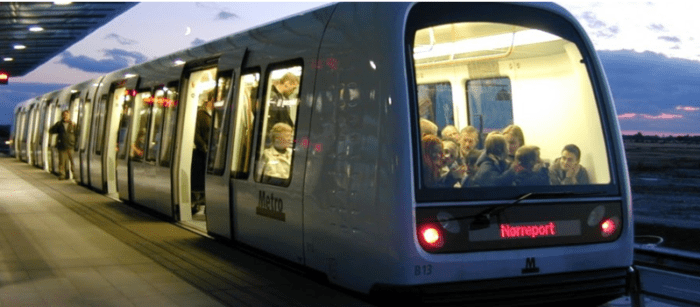
This is what the front of the metro trains look like.
Picture: https://www.atkinsglobal.com/en-GB/projects/copenhagen-metro-city-circle-line
Trains (The S-Train and Regional Trains)
The S-train helps connect suburban areas outside of Copenhagen with the center of the city, and it is ideal for commuters because bikes can be taken on for free! They have developed a very efficient system for bringing bikes onto and off of the train, with designated bike cars, and separate doors for entering and exiting with a bike. The S-train has six lines plus one extra that runs during rush hour, and is designed around Copenhagen’s finger plan, with the suburbs extending outwards from the main city in five main clusters. I haven’t had much opportunity to take the S-train because it doesn’t service Amager, the part of Copenhagen I’m living in, but the few times I’ve taken it have been great.
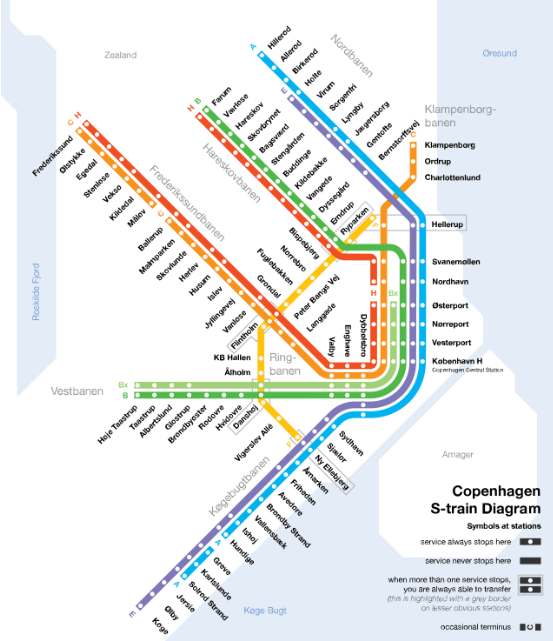
Map of the S-Train routes: https://en.wikipedia.org/wiki/S-train_(Copenhagen)
Copenhagen also has a Regional Train system, which is comparable to Amtrak, with trains running all throughout Denmark, and even southern Sweden.
The Bus
Copenhagen also has a really extensive bus system, which, unlike in America, runs quite smoothly. The buses are reliable and are always on time, and service a good part of the main city and beyond.
There is also a public ferry system, called havnebussen (which translates to harbor bus), that runs along the main canal in the city. I haven’t gotten a chance to take one yet but it seems like it would be really fun!
When you consider all of these transportation options, you can easily get anywhere in the city. This map below shows all of the bus, train, and metro stops throughout Copenhagen, and it’s pretty remarkable how much of the city is covered by some form of transportation. The rest is close enough to a public transit stop that it can be walked or cycled to.
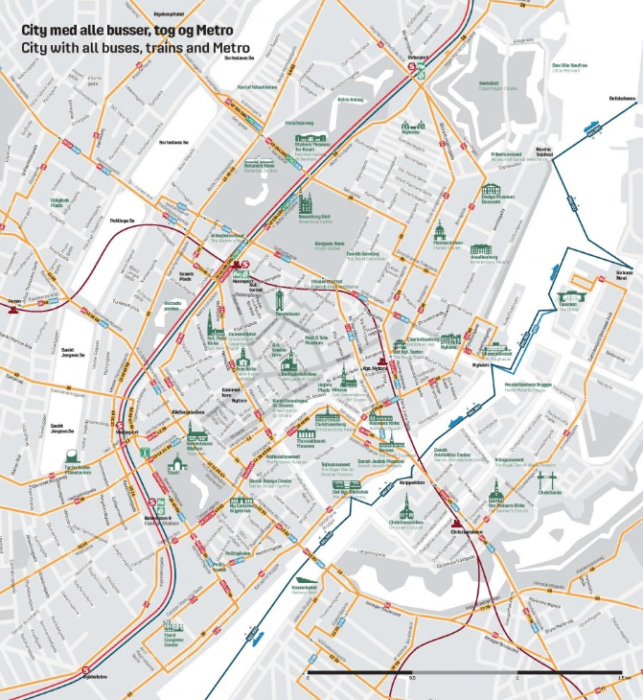
Map: https://www.scandinaviastandard.com/public-transport-in-copenhagen/#bus
As a side note, last weekend I went to Helsinki, Finland, which also had really easy public transit. There was much less biking there, although they did have designated bike lanes throughout most of the city. While they do have buses and trains, the tram system is the main form of transit in the center of Helsinki. It was so cool to see the track on the roads, and it is very well organized! I also took a ferry boat as part of public transportation to Suomenlinna, an old military fortress and UNESCO World Heritage site.
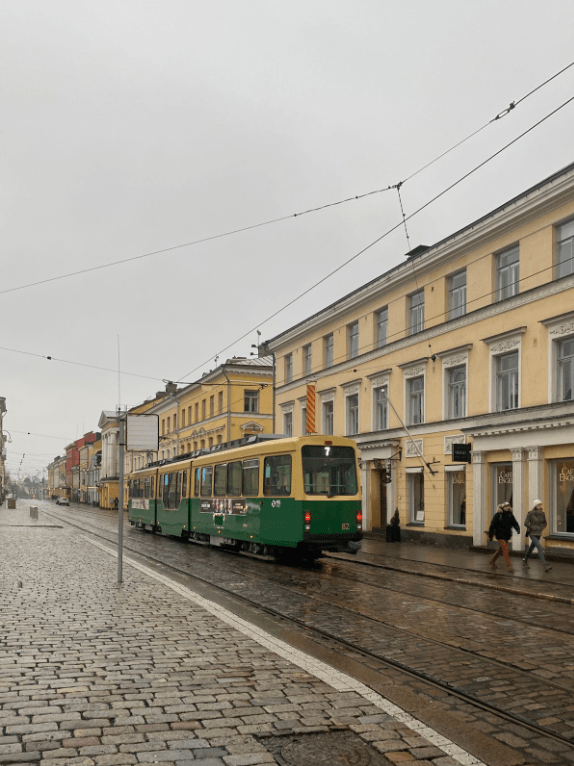
The tram system in Helsinki.
Overall, my experience thus far with getting around Copenhagen has been great. I’ve mostly been biking, because it’s the most convenient way to get around from where I live and I really love biking around the city. When I have taken transit, I’ve been impressed with its efficiency, convenience, and ease. While most of the public transportation options are decently expensive (as most things are here), the quality helps make up for it. Another pro to biking, though — it’s free!
Happy navigating,
Rebecca